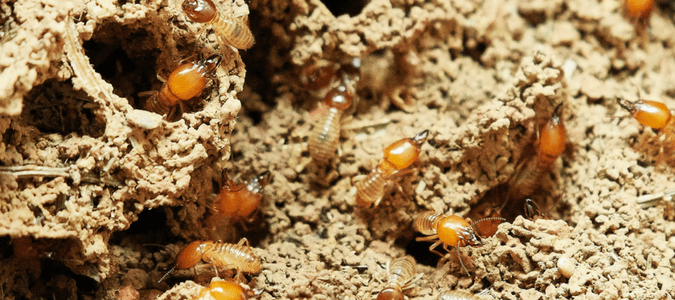
Even though you try to keep your home well-maintained, you’re no stranger to having bugs indoors. Flies buzz in when you leave the door open while grilling. Spiders creep around in the corners and (hopefully) catch those flies. Ants show up every once in a while to remind you that it’s not a good idea to leave out that last piece of pie.
So, while you wouldn’t call yourself an expert, you pretty much know what the most common bugs look like. Right now, though, you’re just not sure. Was that swarm of flying bugs you came across the other day ants? They kind of looked like ants, but perhaps they were another type of insect entirely. You’ve heard that people sometimes mistake termites for ants, so now you’re worried.
How can you tell the difference? Should you be calling someone in?
No matter who you are, the thought of having termites invade your home is a terrifying one–and with good reason. Do you know what the number one threat to wood homes is? Not fire. Not flood. Not wind.
It’s termites.
These insects may be incredibly tiny, but every year they cause $5 billion in damage to wooden structures. These creatures were pretty much designed to literally eat you out of house and home. If there’s a possibility you might have termites, that thought can keep you up at night.
Many homeowners are understandably petrified at the thought that termites may have caused tens–or even hundreds–of thousands in damage to their home. Sometimes, it can seem like a good idea to wait to take action, because perhaps you weren’t absolutely sure it was termites that you saw. Maybe you saw the creatures with your own eyes and simply didn’t know enough to identify them or worry about it.
Because of the significant threat that these pests can pose to your largest investment, we will do our best below to give you the tools you need to distinguish these pests from other insects. You’ll learn more about these pests, what they look like, how to tell the difference between flying ants and flying termites and answers to other questions homeowners commonly have about these insects.
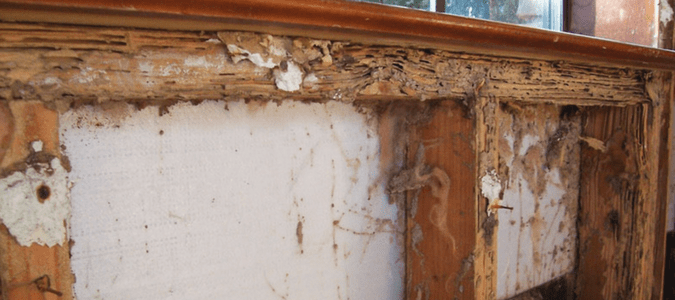
What Do Termites Eat In My Wood?
Termites eat wood, right? That seems pretty basic. It’s why you’re reading this article–to protect the wood “bones” of your house!
But as with most things, there’s a little more to it than that. What these pests are really after is the cellulose which is the building block of the wood that makes up your home’s foundation.
Why does this matter? Because cellulose is also found in plants, cotton fibers (like in your clothing), paper products and more. If you notice any of these things are being eaten, it can be a sign you have termites.
What other things about termites are important for homeowners to know?
First off, the two main types of termites you need to worry about in the south are subterranean termites and drywood termites. The nests of subterranean termites come into contact with the soil (hence the name), while drywood termites nest in the wood itself.
It is quite possible that you might run into either of these varieties, and both need to be dealt with quickly and thoroughly. But for the sake of this article, we’ll focus on the subterranean variety, because they do the most damage.
There are three types, or castes, of termites in a colony:
- Reproductives
- Workers
- Soldiers
If you’ve ever seen a piece of wood with termites, you’re probably most familiar with workers. They range in color from creamy white to brown or black, with large mandibles jutting from their heads. Soldier termites are kind of like a bigger, meaner-looking version of workers, and their heads are often a different color.
Unless you stumble upon a colony in your walls though, you don’t really need to worry about what those castes look like. The one that matters is the reproductive caste.
Why? Swarmers.
Swarmers are winged termites that often serve as the vanguard for a colony, scouting ahead to see if a particular structure is suitable for a nest.
These are also the kinds of termites that people often confuse with ants, which brings us to our next question.
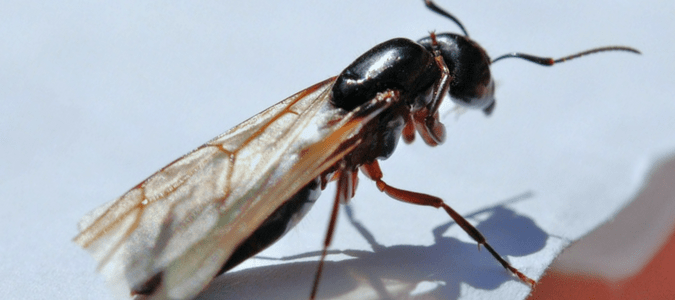
What Do Flying Ants Look Like?
Just like termites, some ants can fly. You’ve likely seen winged ants before, but haven’t really given them much thought or paid a lot of attention to how they look. Ants are at the top of the list of bugs that look like termites but aren’t, so it’s good to learn about the appearance of the flying ant so you can try to distinguish these insects from a termite.
Well, start paying attention, because it matters if you need to determine whether you’re dealing with a flying ant or a swarmer termite.
Flying ants have the following characteristics:
- Two sets of wings, with the back set clearly shorter than the front set
- Antennae with a 90-degree bend
- A pinched or skinny waist
Of these defining characteristics, the two most noticeable ones are probably the wings of different length and the skinny waist.
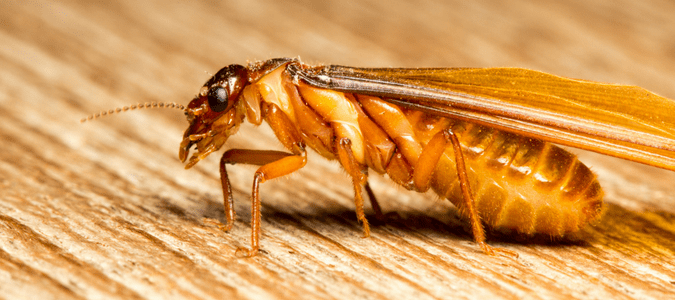
What Does A Termite Look Like With Wings?
Reproductives are the only type of subterranean termite you are likely to see, since the other castes are busy underground, eating literally nonstop while swarmers come out to find a new location for the colony. Swarmer termites have the following characteristics:
- Antennae that are basically straight
- Two sets of wings that are equal in length, and significantly longer in proportion to the body
- Uniform body (i.e. the waist is not pinched)
As with flying ants, the two most noticeable differences are the wings and (especially) the straight, seemingly unsegmented body.
Unfortunately, that’s not a whole lot to go on, unless you can look really closely or catch one to examine it for a while.
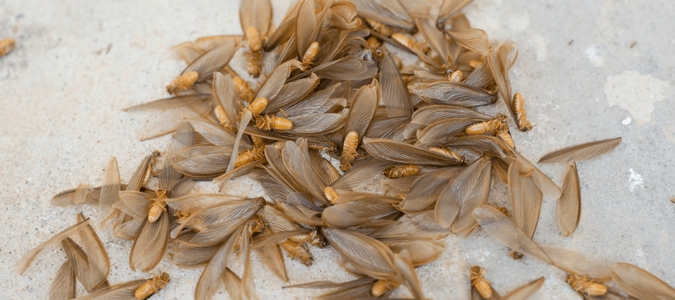
What Do Flying Termites Look Like?
Yeah, flying termites and flying ants look pretty similar. Worse, both swarmers and flying ants have their mating cycles in the spring, so both types of insects tend to be out and about around the same time.
So, you have to move past looks. Thankfully, there is one huge difference between the two: discarded wings.
Let’s say you notice a bunch of discarded insect wings on a windowsill or the ground. What does it mean? Are they from flying ants? Swarmers? Both?
Here’s the good news and the bad news: flying ants do not shed their wings.
This is good news, because it means you have a fairly clear, simple way of determining what you’re dealing with. But it’s bad news because a huge pile of discarded wings means termites. Worse, it means they might already be inside.
What do you do next? Do what the EPA and other federal agencies recommend: contact a trusted pest control company. If termite control measures are ineffective, you are in for an unwelcome and costly surprise to remedy the damage these pesky pests have done to your home.
What if you don’t notice swarmers, yet still worry you might be infested?
Other Signs A House Is Infested With Termites
Since termites are often in hard to access places and the average homeowner can’t easily tell termites have invaded, the best way to determine if you’re dealing with an infestation is to have an experienced professional come out and investigate. Short of that, though, there are still some signs you can look for.
Wood That Sounds Hollow
Termites essentially eat tunnels through the wood in your walls, floors and ceilings without ever coming up to the surface, so if you’re looking from the outside in, everything looks fine. It might not sound fine, though, because the wood that was once there is now gone, leaving empty space. This can create a hollow sound when you tap on the exterior of wood that termites have eaten through.
Frass
There’s no delicate way to put this–frass is termite droppings. This waste material is the color of wood, and they’re often left behind after termites have eaten through an area. If you come across them, get in touch with us immediately.
Mud Tubes
Termites do not like being out in the sun. At all. They do whatever they can to stay covered. If they have to move from place to place in the open, often these pests will create mud tubes to protect themselves from the sun and keep them moist while traveling. These passageways can commonly be found on exterior walls.
Paint Cracks And Distortions
This is more a worry for drywood termites than the subterranean variety, but these pests can squeeze into openings that are thinner than a dime’s edge. If you have any cracks near windows, siding, vents or the foundation, your home is at greater risk for an infestation.
How To Eliminate A Termite Infestation And Keep Termites Out
Removing a colony of termites from your home is a big job. You want to make sure you do the job right the first time, so none of these pests escape to wreak more havoc on your home.
Because of this, even though there are some options out there, going the DIY route and using over-the-counter termite treatments is not recommended. The most likely outcome (which some DIY proponents even admit) is that you will reduce their population, but not completely get rid of them.
When you’re talking about your home, this simply isn’t acceptable. The only true way to rid yourself of a termite infestation is to do your due diligence and reach out to a knowledgeable pest control company that you trust.
Even then, you need to pay careful attention to their instructions about vacating your house and when you can return–termite treatment is serious.
Where you can make a big difference is in prevention. Here are just a few tips to stop termites before they ever get to your home:
Reduce Moisture Inside And Outside
Eliminating water sources that can attract termites can involve getting rid of standing water, making sure you don’t overwater, handling leaks and fixing AC units so condensation doesn’t build up. Additionally, you want to ensure water is diverted away from your home with splash blocks, gutters and downspouts.
Repair And Replace
It doesn’t take much for termites to get in, so it is very important that you check for and fix loose mortar around windows and the basement foundation, roof shingles that have rotted, soffits, fascia and weather stripping.
Monitor
You need to keep an eye out for mud tubes, watch for paint that bubbles or is uneven, tap wood to make sure it doesn’t sound hollow and just generally keep a look out for any exterior wood areas with noticeable changes.
Mind The Gap
You always want to make sure there is a gap of at least 18 inches between the wood parts of your house and the soil. Another gap you want: keep any firewood at least 20 feet away.
Get An Annual Inspection.
Yes, it’s an extra cost, but it’s worth it. Why? Because if you do get a termite infestation, your homeowner’s insurance most likely will not cover it. That means the sooner you find out about it, the less money you’ll be on the hook for.
ABC Can Protect Your Property From Termite Damage
Bottom line? If you think there’s even a small possibility there are termites in your home, it is absolutely vital that you get professional help immediately. If it turns out that you’re wrong, at least you’ll get the peace of mind that comes with having a skilled pest technician inspect your home. ABC Home & Commercial Services has been protecting homes from termite damage for generations. With ABC’s help, you won’t have to worry about your home being at risk.
